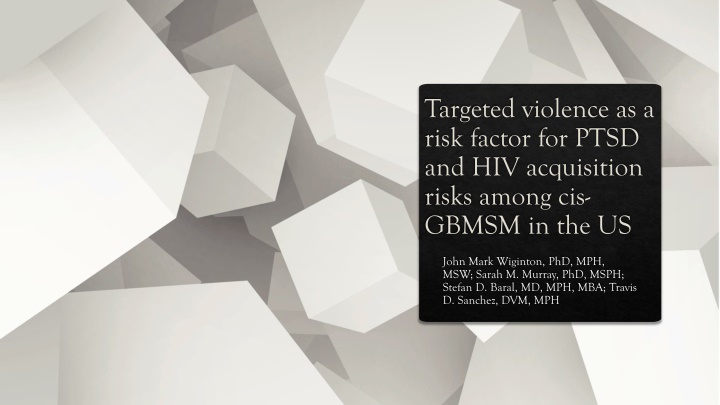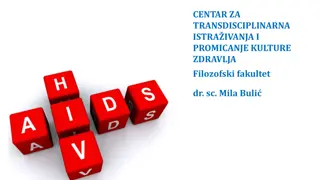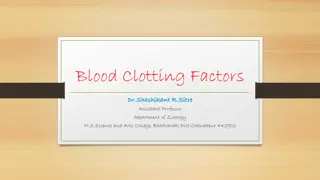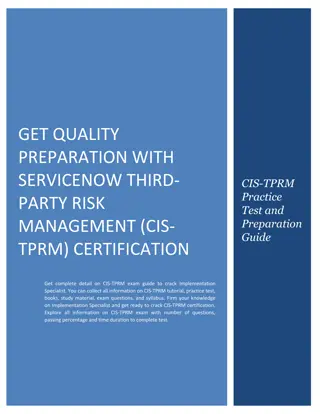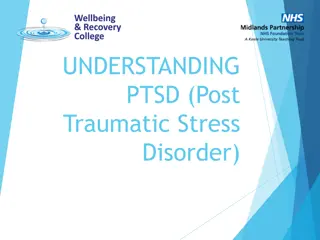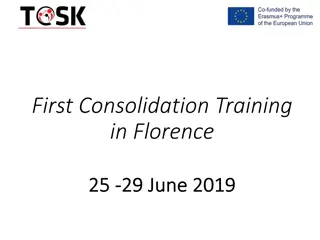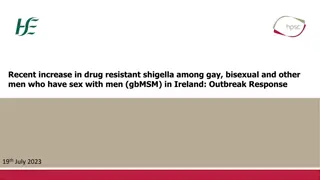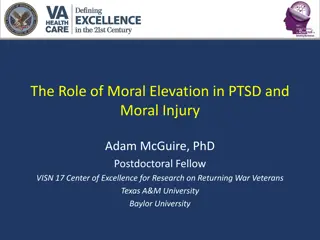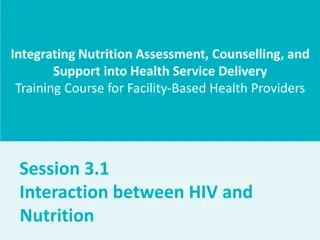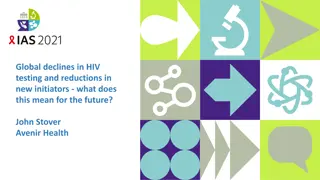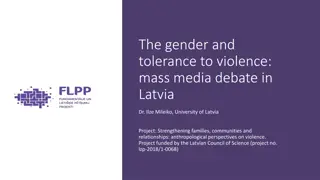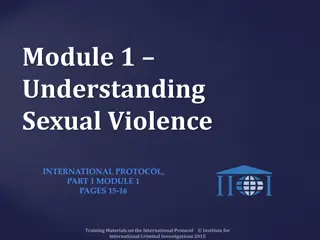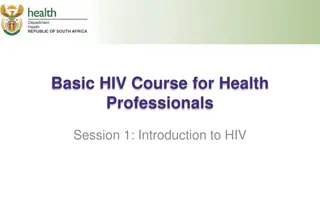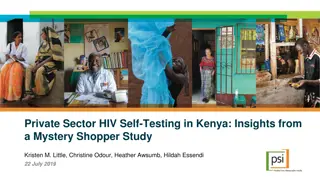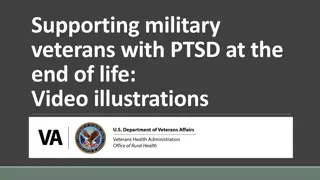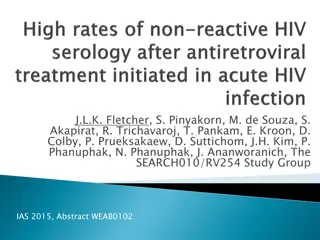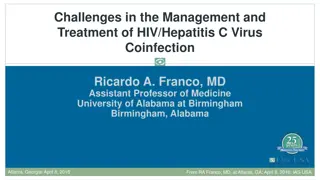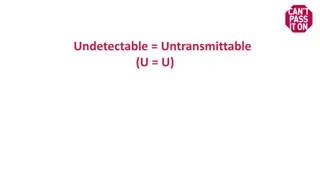Targeted Violence as a Risk Factor for PTSD and HIV Among Cis-GBMSM in the US
Cis-GBMSM individuals often face interpersonal violence, impacting their mental health and HIV risks. This study examines violence attribution, PTSD prevalence, and associations with serodiscordant condomless anal sex.
Download Presentation

Please find below an Image/Link to download the presentation.
The content on the website is provided AS IS for your information and personal use only. It may not be sold, licensed, or shared on other websites without obtaining consent from the author.If you encounter any issues during the download, it is possible that the publisher has removed the file from their server.
You are allowed to download the files provided on this website for personal or commercial use, subject to the condition that they are used lawfully. All files are the property of their respective owners.
The content on the website is provided AS IS for your information and personal use only. It may not be sold, licensed, or shared on other websites without obtaining consent from the author.
E N D
Presentation Transcript
Targeted violence as a risk factor for PTSD and HIV acquisition risks among cis- GBMSM in the US John Mark Wiginton, PhD, MPH, MSW; Sarah M. Murray, PhD, MSPH; Stefan D. Baral, MD, MPH, MBA; Travis D. Sanchez, DVM, MPH
Background Cisgender gay, bisexual, and other men who have sex with men (cis-GBMSM) are disproportionately exposed to interpersonal violence,1,2often motivated by sexual prejudice3,4 Such violence, regardless of motivation, carries highest conditional risk for Posttraumatic Stress Disorder (PTSD),5which also disproportionately impacts cis-GBMSM6 PTSD has been consistently linked to HIV-transmission risk behaviors among cis-GBMSM7-9 Objectives Determine prevalence of cis-GBMSM who do, do not, and are unsure about whether to attribute experiences of interpersonal violence to engagement in same-sex practices Assess prevalence of PTSD across attribution groups Test attribution-PTSD associations and PTSD-serodiscordant condomless anal sex associations
Methods American Men s Internet Survey (2020)10 Has someone ever physically hurt you (pushed, shoved, slapped, hit, kicked, choked or otherwise physically hurt you)? 13,081 began the survey 9,225 responded to a set of sexual behavior stigma items, one of which pertained to physical violence Do you believe any of these experiences of physical violence was/were related to the fact that you have sex with men? 2,886 (31.3%)
Methods (cont.) Variables Violence attribution (categorical): Unrelated (reference), related, or unsure PTSD (binary): 8-item Posttraumatic Checklist for the DSM-511 past 30 days Serodiscordant condomless anal sex with a man (binary) past year Covariates: age, race/ethnicity, sexual identity, education, HIV status, urbanicity Analysis Modified Poisson regression with robust variance estimation #1: Independent variable, violence attribution; dependent variable, PTSD #2: Independent variable, PTSD; dependent variable, serodiscordant condomless anal sex
Results Violence attribution Sample characteristics Mean age, 33.5 yrs (median, 27); 9%, teen 62%, non-Hispanic white 79%, homosexual/gay-identified; 18%, bisexual 42%, college degree or graduate education 39%, residence in large central metro area 71%, HIV-negative; 11%, HIV-positive 23%, serodiscordant condomless anal sex 23%, PTSD
Results (cont.) PTSD prevalence by attribution group Adjusted prevalence ratio with 95% confidence intervals between violence attribution and PTSD No attribution to same- sex practices (ref.) Attribution to same-sex practices Unsure 1.00 1.55 (1.34, 1.79) 1.80 (1.44, 2.25)
Results (cont.) PTSD prevalence by age group Adjusted interaction effect of binary age (15-19 years vs 20+ years) and violence attribution on PTSD No attribution to same- sex practices*age (ref.) Attribution to same-sex practices*age Unsure*age 1.00 1.49 (1.01, 2.20) 1.30 (0.77, 2.20)
Results (cont.) Age moderates the effect of violence attribution on PTSD
Results (cont.) Adjusted prevalence ratio with 95% confidence intervals between PTSD and serodiscordant condomless anal sex, confirming PTSD & HIV- transmission risk association Adjusted interaction effect of violence attribution and PTSD on serodiscordant condomless anal sex No attribution to same- sex practices*PTSD (ref.) Attribution to same-sex practices*PTSD Unsure*PTSD 1.00 No PTSD (ref.) 1.00 1.22 (0.93, 1.59) PTSD 1.22 (1.08, 1.38) 1.08 (0.71, 1.63)
Limitations Lifetime interpersonal physical violence not designated as index trauma Can be difficult to make attributions; basis not assessed Cross-sectional data; different recall periods for variables of interest Survey completed in latter 2020, well into COVID-19 pandemic Heightened mental health concerns and additional sources of PTSD/exacerbation of PTSD symptoms
Conclusions Higher PTSD risk for those who attributed violence to sexual prejudice, amplified among teens; additionally, higher risk for those unsure about attribution Improved screening to identify violence-exposed cis-GBMSM with these attribution patterns Combined PTSD/sexual risk-reduction interventions12,13 For teens, developmental tailoring; structural barriers may constrain access or impede implementation Longitudinal research to establish temporal ordering to test HIV acquisition risks via PTSD pathways
Acknowledgements MAC AIDS Fund, National Institutes of Health (R01MH110358, P30AI050409) the Emory Center for AIDS Research. Emory and Johns Hopkins research team Coauthors
References McKay, T., Lindquist, C. H., & Misra, S. (2019). Understanding (and acting on) 20 years of research on violence and LGBTQ + communities. Trauma, Violence & Abuse, 20(5), 665-678. doi:10.1177/1524838017728708 [doi] National Academies of Sciences, Engineering, and Medicine. (2020). Understanding the well-being of LGBTQI+ populations. Washington, DC: The National Academies Press. doi:https://doi.org/10.17226/25877 Freeman, J. Q., Cha, S., Wejnert, C., & Baugher, A. (2022). Physical and sexual violence and sexual behaviors among men who have sex with men in 22 U.S. cities-national HIV behavioral surveillance, 2017. Journal of Interpersonal Violence, , 8862605221078821. doi:10.1177/08862605221078821 [doi] Herek, G. M. (2009). Hate crimes and stigma-related experiences among sexual minority adults in the united states: Prevalence estimates from a national probability sample. Journal of Interpersonal Violence, 24(1), 54-74. doi:10.1177/0886260508316477 [doi] Kessler, R. C., Sonnega, A., Bromet, E., Hughes, M., & Nelson, C. B. (1995). Posttraumatic stress disorder in the national comorbidity survey. Archives of General Psychiatry, 52(12), 1048-1060. Roberts, A. L., Austin, S. B., Corliss, H. L., Vandermorris, A. K., & Koenen, K. C. (2010). Pervasive trauma exposure among US sexual orientation minority adults and risk of posttraumatic stress disorder. American Journal of Public Health, 100(12), 2433-2441. doi:10.2105/AJPH.2009.168971 [doi] Reisner, S. L., Mimiaga, M. J., Safren, S. A., & Mayer, K. H. (2009). Stressful or traumatic life events, post-traumatic stress disorder (PTSD) symptoms, and HIV sexual risk taking among men who have sex with men. AIDS Care, 21(12), 1481-1489. doi:10.1080/09540120902893258 [doi] O'Cleirigh, C., Traeger, L., Mayer, K. H., Magidson, J. F., & Safren, S. A. (2013). Anxiety specific pathways to HIV sexual transmission risk behavior among young gay and bisexual men. Journal of Gay & Lesbian Mental Health, 17(3), 314-326. doi:10.1080/19359705.2012.755142 [doi] Sweet, T., & Welles, S. L. (2012). Associations of sexual identity or same-sex behaviors with history of childhood sexual abuse and HIV/STI risk in the united states. Journal of Acquired Immune Deficiency Syndromes (1999), 59(4), 400-408. doi:10.1097/QAI.0b013e3182400e75 [doi] Zlotorzynska, M., Sullivan, P., & Sanchez, T. (2017). The annual american men's internet survey of behaviors of men who have sex with men in the united states: 2015 key indicators report. JMIR Public Health and Surveillance, 3(1), e13. doi:10.2196/publichealth.7119 [doi] Price, M., Szafranski, D. D., van Stolk-Cooke, K., & Gros, D. F. (2016). Investigation of abbreviated 4 and 8 item versions of the PTSD checklist 5. Psychiatry Research, 239, 124-130. doi:S0165-1781(15)30066-4 [pii] O Cleirigh, C., Safren, S.A., Taylor, S.W., Goshe, B.M., Bedoya, C.A., Marquez, S.M., Boroughs, M.S., & Shiperd, J.C. (2019). Cognitive behavioral therapy for trauma and self-care (CBT-TSC) in men who have sex with men with a history of childhood sexual abuse: A randomized controlled trial. AIDS and Behavior, 23, 2421-2431. https://doi.org/10.1007/s10461-019-02482-z Ye, Z., Yu, N.X., Zhu, W., Chen, L., & Lin, D. (2018). A randomized controlled trial to enhance coping and posttraumatic growth and decrease posttraumatic stress disorder in HIV-infected men who have sex with men in Beijing, China. AIDS Care, 30(6), 793-801. DOI: 10.1080/09540121.2017.1417534
